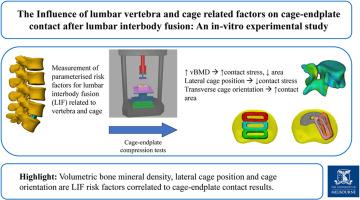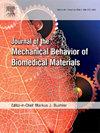The influence of lumbar vertebra and cage related factors on cage-endplate contact after lumbar interbody fusion: An in-vitro experimental study
IF 3.3
2区 医学
Q2 ENGINEERING, BIOMEDICAL
Journal of the Mechanical Behavior of Biomedical Materials
Pub Date : 2024-09-21
DOI:10.1016/j.jmbbm.2024.106754
引用次数: 0
Abstract
Lumbar interbody fusion (LIF) using interbody cages is an established treatment for lumbar degenerative disc disease, but fusion results are known to be affected by risk factors such as bone mineral density (BMD), endplate geometry and cage position. At present, direct measurement of endplate-cage contact variables that affect LIF have not been fully identified. The aim of this study was to use cadaveric experiments to investigate the dependency between BMD, endplate geometry, cage parameters like type, orientation, position, and contact variables like stress and area. One vertebral body specimen from each of the five lumbar positions was harvested from five male donors. The lower half of each vertebra was potted and placed in a material testing machine (Instron 8874). A spinal cage was clamped to the machine then lowered to bring it into contact against the superior endplate. A lockable ball-joint was used to rotate the cage such that its inferior surface was congruent with the local endplate surface. A pressure sensor (Tekscan) was placed between the cage and endplate to record contact area and the peak and average contact pressures. Axial compression of 400 N was performed for five positions using a straight cage, and in one anterior position using a curved cage. The linear mixed model was utilised to perform data analyses for experimental results with statistical significance set at p < 0.05. The results indicated two trends toward significance for contact area, one for volumetric BMD (vBMD) of the vertebra (p = 0.081), and another for predicted contact area (p = 0.057). Peak contact pressure correlated significantly with vBMD (p = 0.041), and there was a trend between average contact pressure and lateral position of cage (p = 0.051). In addition, predicted contact area correlated significantly with cage orientation (p < 0.001). These results indicated that high vBMD of vertebra and a medially positioned cage led to higher contact pressures. Logically, low vBMD of vertebra and transverse cage orientation increased the contact area between the cage and endplate. In conclusion, the study identified significant influence of vBMD of vertebra, cage position and orientation on cage-endplate contact which may help to inform cage selection and design for LIF.

腰椎和椎笼相关因素对腰椎椎间融合术后椎笼-端板接触的影响:体外实验研究
使用椎间融合器进行腰椎间盘融合术(LIF)是治疗腰椎间盘退行性疾病的一种成熟疗法,但众所周知,融合术的效果会受到骨矿密度(BMD)、椎板末端几何形状和椎间融合器位置等风险因素的影响。目前,对影响 LIF 的终板-椎弓根接触变量的直接测量尚未完全确定。本研究的目的是利用尸体实验研究 BMD、终板几何形状、保持架参数(如类型、方向、位置)与接触变量(如应力和面积)之间的关系。从五名男性捐献者的五个腰椎位置各采集了一个椎体标本。每个椎体的下半部分被装入盆中,并放入材料试验机(Instron 8874)中。将脊柱保持架夹在机器上,然后放下,使其与上椎体终板接触。用一个可锁定的球形关节旋转脊柱笼,使其下表面与局部终板表面一致。压力传感器(Tekscan)被放置在保持架和终板之间,以记录接触面积以及接触压力的峰值和平均值。使用直笼对五个位置进行了400 N的轴向加压,并使用弯笼对一个前方位置进行了轴向加压。实验结果采用线性混合模型进行数据分析,统计显著性设定为 p <0.05。结果表明,接触面积有两个显著性趋势,一个是椎体体积 BMD(vBMD)(p = 0.081),另一个是预测接触面积(p = 0.057)。峰值接触压力与 vBMD 显著相关(p = 0.041),平均接触压力与保持架的侧向位置之间存在趋势(p = 0.051)。此外,预测的接触面积与椎弓根方向有显著相关性(p < 0.001)。这些结果表明,椎体的高vBMD和保持架的内侧位置会导致较高的接触压力。从逻辑上讲,低vBMD椎体和横向保持架方向增加了保持架和终板之间的接触面积。总之,该研究发现了椎体vBMD、保持架位置和方向对保持架与终板接触的重要影响,这可能有助于为LIF选择和设计保持架提供参考。
本文章由计算机程序翻译,如有差异,请以英文原文为准。
求助全文
约1分钟内获得全文
求助全文
来源期刊

Journal of the Mechanical Behavior of Biomedical Materials
工程技术-材料科学:生物材料
CiteScore
7.20
自引率
7.70%
发文量
505
审稿时长
46 days
期刊介绍:
The Journal of the Mechanical Behavior of Biomedical Materials is concerned with the mechanical deformation, damage and failure under applied forces, of biological material (at the tissue, cellular and molecular levels) and of biomaterials, i.e. those materials which are designed to mimic or replace biological materials.
The primary focus of the journal is the synthesis of materials science, biology, and medical and dental science. Reports of fundamental scientific investigations are welcome, as are articles concerned with the practical application of materials in medical devices. Both experimental and theoretical work is of interest; theoretical papers will normally include comparison of predictions with experimental data, though we recognize that this may not always be appropriate. The journal also publishes technical notes concerned with emerging experimental or theoretical techniques, letters to the editor and, by invitation, review articles and papers describing existing techniques for the benefit of an interdisciplinary readership.
 求助内容:
求助内容: 应助结果提醒方式:
应助结果提醒方式:


